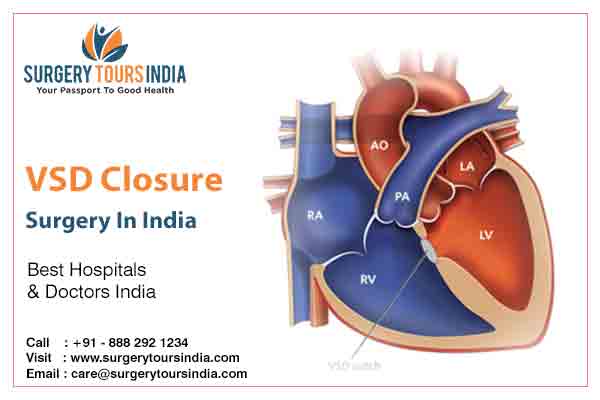
A ventricular septal defect (VSD) is a type of birth defect (congenital condition) which results in the development of a hole in the wall separating the two lower chambers (ventricular chambers) of the heart. This wall of membranous tissue and inferior muscles is known as the ventricular septum and the hole is more commonly seen in the membranous portion of the septum (chamber wall).
Ventricular septal defect (VSD) is mostly a congenital (birth) defect that is seen in infants around a few weeks after birth.
Some of the signs and symptoms seen in a developing VSD include pansystolic murmur in the lower left sterna border, troubled blood flow, irregular heartbeat as well as pulmonary hypertension as a result of increase in the blood flow. Eisenmenger's syndrome may also be caused which results in the pressure to increase in the pulmonary vascular bed.
The cause of most cases of VSD is related to a pre-existence of Down syndrome which increases the risk even further of developing VSD. In case the child suffers from a myocardial infarction (heart attack) which causes the septal wall to tear and the scar tissue forms because the macrophages are unable to repair the dead tissues.
Many cases where the septal wall develops a smaller sized hole do not need to be treated as it repairs itself after a few years without causing adverse affects in the meanwhile.
Surgical intervention procedure is required in case of VSDs when:
There are basically two different types of surgical procedures that are used for VSD closure. The choice of treatment depends mainly on the size of the hole in the ventricle wall.
This is a minimally invasive surgical procedure that uses a catheter to place an artificial spindle-shaped implant (occluder) made of fibrous mesh to seal the hole in the ventricle wall.
The surgeon uses general anesthesia for this procedure and starts with an incision in the groin area. This incision is used to insert a catheter (thin tube) into one of the many major blood vessels and use the catheter to reach the heart through this blood vessel. This catheter also has the occluder attached to it and is placed precisely in the VSD opening in the ventricle wall. The occluder is large enough to completely seal the breach in the ventricle wall and stops the mixing of blood directly between the two ventricles. The catheter is then removed and the incision is then closed.
A larger VSD hole will mostly require the surgeon to perform an open-heart surgery. The surgeon administers a general anesthesia to put you out of consciousness. The surgeon will then make a large incision along your sternum (breast bone) to gain access to the heart under the rib cage and muscles. The aortas and the lungs are connected to an external machine, known as the 'heart-lung bypass' device. The heart's beating is stopped so the surgeon can perform the required repairs.
The surgeon will gain access to the lower portion inside the heart and, according to the extent and location of the hole, either use a grafted material patch or an artificial patch if the location and the size of the hole permit the use to seal the hole in the ventricle wall.
In case the hole's shape, size or location is not suitable to be fixed with a patch the surgeon will use suture techniques using strong and thin polypropylene suture material to stitch the hole closed.
The incision is then closed after reconnecting the heart and lungs normally.
A few days to a week's hospital stay is usually advised by the doctor after undergoing treatment for VSD closure to observe for any irregularities and possible complications.
The cardiac specialty hospitals and clinics in India are part of a large and wide network that have the most modern and advanced medical and surgical equipments at their disposal to ensure that a major and delicate type of surgery such as the VSD closure procedure is done with utmost efficiency. The cardiac surgeons and doctors in India are extensively trained and have immense experience in managing complicated cases involving VSD closure and other treatment procedures related to the heart.
Surgery Tours India Medical Tourism Consultants are the forerunners in the field of managing varied and diverse cases relating to cardiac disorders and surgeries. The team of expert consultants at Surgery Tours India is well-versed in all the possible and the most efficient manners of treatment of VSD closure with connections to the best and the biggest hospitals and clinics in all major Indian cities. Surgery Tours India consultants will ensure that you get the best kind of treatment and a memorable experience all at the lowest cost in India.
For more information please contact us at
Email: [email protected]
Phone: +91-888 292 1234 / +91-9730 001 540